Article Critique: Motivation, Efficiency, and Organizational Behavior
VerifiedAdded on 2020/03/23
|7
|2319
|49
Report
AI Summary
This report provides a critical analysis of the article by Guney & Guclu (2017), which examines the role of motivation techniques in enhancing performance and productivity within organizations. The article emphasizes the importance of motivation in talent development and efficiency, particularly in the context of contemporary organizations and strategic personnel management. The critique highlights the study's methodology, including its sample size and focus on factory workers, while also acknowledging its limitations. The report discusses the article's strengths, such as its emphasis on efficiency as a key economic element and its identification of motivational factors, while also pointing out gaps in the discussion of motivational theories and the lack of individual employee focus. The analysis also considers the broader implications of the study, including its relevance to global organizations, cultural diversity, and employee retention strategies. The report concludes by summarizing the article's key findings and limitations, emphasizing the need for a more in-depth exploration of motivational techniques and their impact on individual employees. This is a past paper contributed by a student and available on Desklib.
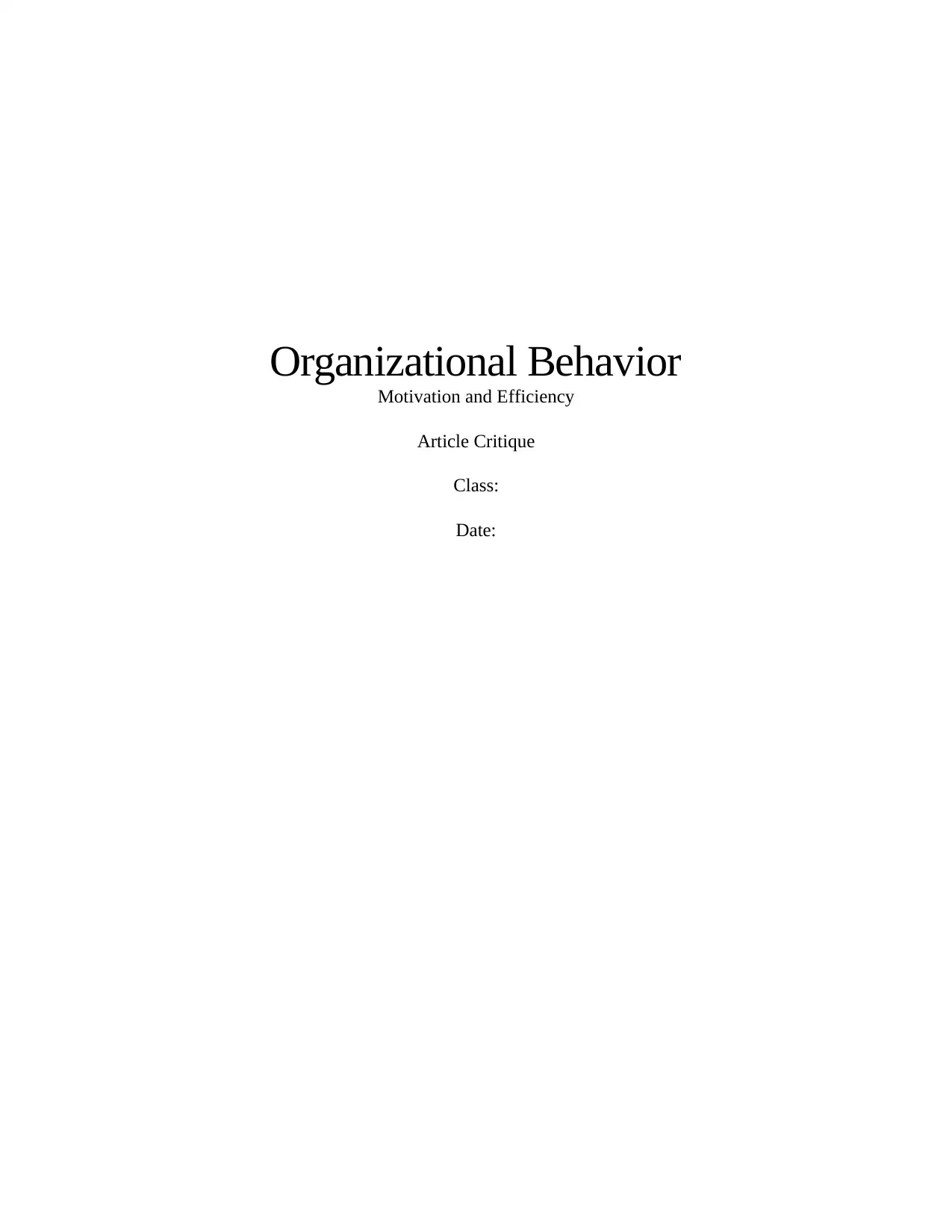
Organizational Behavior
Motivation and Efficiency
Article Critique
Class:
Date:
Motivation and Efficiency
Article Critique
Class:
Date:
Paraphrase This Document
Need a fresh take? Get an instant paraphrase of this document with our AI Paraphraser
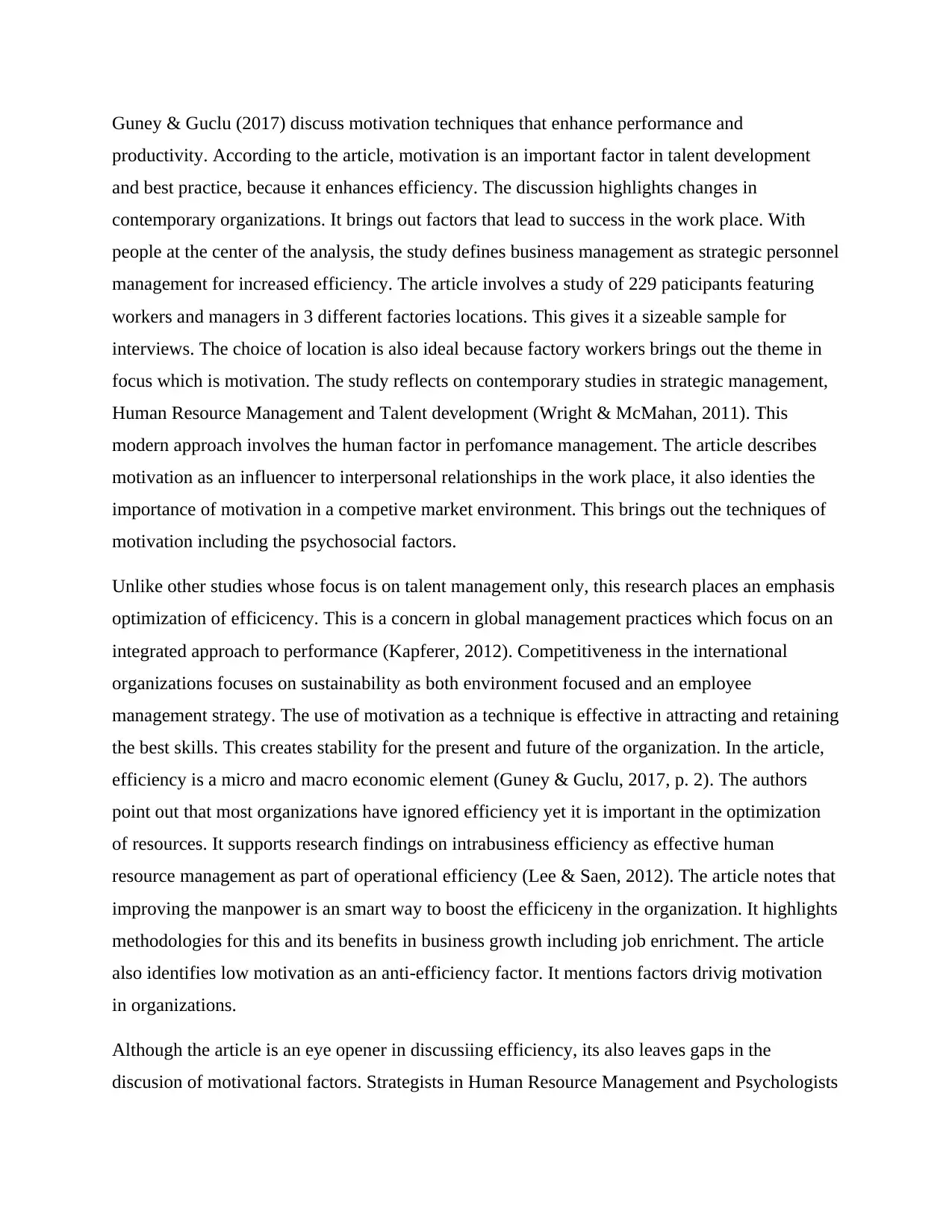
Guney & Guclu (2017) discuss motivation techniques that enhance performance and
productivity. According to the article, motivation is an important factor in talent development
and best practice, because it enhances efficiency. The discussion highlights changes in
contemporary organizations. It brings out factors that lead to success in the work place. With
people at the center of the analysis, the study defines business management as strategic personnel
management for increased efficiency. The article involves a study of 229 paticipants featuring
workers and managers in 3 different factories locations. This gives it a sizeable sample for
interviews. The choice of location is also ideal because factory workers brings out the theme in
focus which is motivation. The study reflects on contemporary studies in strategic management,
Human Resource Management and Talent development (Wright & McMahan, 2011). This
modern approach involves the human factor in perfomance management. The article describes
motivation as an influencer to interpersonal relationships in the work place, it also identies the
importance of motivation in a competive market environment. This brings out the techniques of
motivation including the psychosocial factors.
Unlike other studies whose focus is on talent management only, this research places an emphasis
optimization of efficicency. This is a concern in global management practices which focus on an
integrated approach to performance (Kapferer, 2012). Competitiveness in the international
organizations focuses on sustainability as both environment focused and an employee
management strategy. The use of motivation as a technique is effective in attracting and retaining
the best skills. This creates stability for the present and future of the organization. In the article,
efficiency is a micro and macro economic element (Guney & Guclu, 2017, p. 2). The authors
point out that most organizations have ignored efficiency yet it is important in the optimization
of resources. It supports research findings on intrabusiness efficiency as effective human
resource management as part of operational efficiency (Lee & Saen, 2012). The article notes that
improving the manpower is an smart way to boost the efficiceny in the organization. It highlights
methodologies for this and its benefits in business growth including job enrichment. The article
also identifies low motivation as an anti-efficiency factor. It mentions factors drivig motivation
in organizations.
Although the article is an eye opener in discussiing efficiency, its also leaves gaps in the
discusion of motivational factors. Strategists in Human Resource Management and Psychologists
productivity. According to the article, motivation is an important factor in talent development
and best practice, because it enhances efficiency. The discussion highlights changes in
contemporary organizations. It brings out factors that lead to success in the work place. With
people at the center of the analysis, the study defines business management as strategic personnel
management for increased efficiency. The article involves a study of 229 paticipants featuring
workers and managers in 3 different factories locations. This gives it a sizeable sample for
interviews. The choice of location is also ideal because factory workers brings out the theme in
focus which is motivation. The study reflects on contemporary studies in strategic management,
Human Resource Management and Talent development (Wright & McMahan, 2011). This
modern approach involves the human factor in perfomance management. The article describes
motivation as an influencer to interpersonal relationships in the work place, it also identies the
importance of motivation in a competive market environment. This brings out the techniques of
motivation including the psychosocial factors.
Unlike other studies whose focus is on talent management only, this research places an emphasis
optimization of efficicency. This is a concern in global management practices which focus on an
integrated approach to performance (Kapferer, 2012). Competitiveness in the international
organizations focuses on sustainability as both environment focused and an employee
management strategy. The use of motivation as a technique is effective in attracting and retaining
the best skills. This creates stability for the present and future of the organization. In the article,
efficiency is a micro and macro economic element (Guney & Guclu, 2017, p. 2). The authors
point out that most organizations have ignored efficiency yet it is important in the optimization
of resources. It supports research findings on intrabusiness efficiency as effective human
resource management as part of operational efficiency (Lee & Saen, 2012). The article notes that
improving the manpower is an smart way to boost the efficiceny in the organization. It highlights
methodologies for this and its benefits in business growth including job enrichment. The article
also identifies low motivation as an anti-efficiency factor. It mentions factors drivig motivation
in organizations.
Although the article is an eye opener in discussiing efficiency, its also leaves gaps in the
discusion of motivational factors. Strategists in Human Resource Management and Psychologists
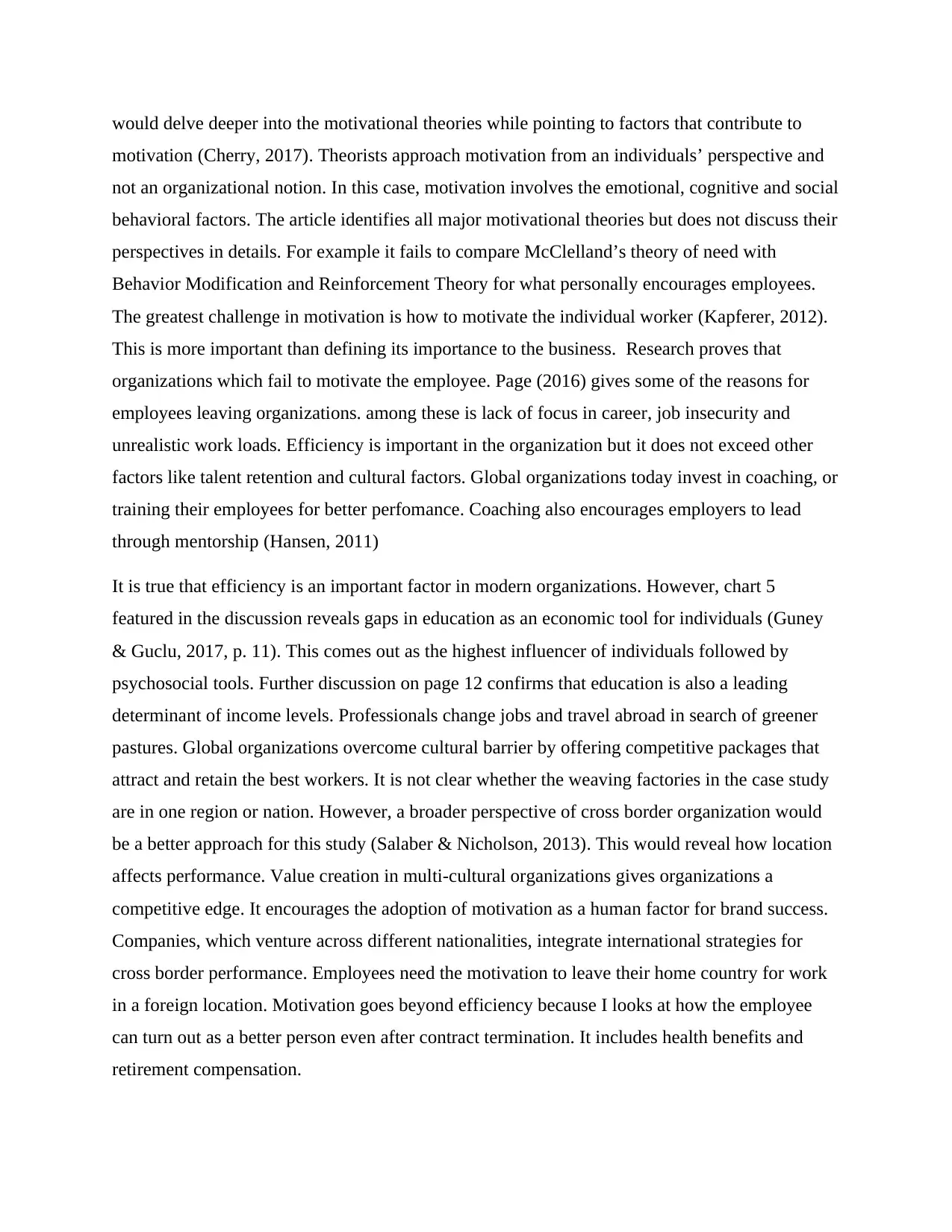
would delve deeper into the motivational theories while pointing to factors that contribute to
motivation (Cherry, 2017). Theorists approach motivation from an individuals’ perspective and
not an organizational notion. In this case, motivation involves the emotional, cognitive and social
behavioral factors. The article identifies all major motivational theories but does not discuss their
perspectives in details. For example it fails to compare McClelland’s theory of need with
Behavior Modification and Reinforcement Theory for what personally encourages employees.
The greatest challenge in motivation is how to motivate the individual worker (Kapferer, 2012).
This is more important than defining its importance to the business. Research proves that
organizations which fail to motivate the employee. Page (2016) gives some of the reasons for
employees leaving organizations. among these is lack of focus in career, job insecurity and
unrealistic work loads. Efficiency is important in the organization but it does not exceed other
factors like talent retention and cultural factors. Global organizations today invest in coaching, or
training their employees for better perfomance. Coaching also encourages employers to lead
through mentorship (Hansen, 2011)
It is true that efficiency is an important factor in modern organizations. However, chart 5
featured in the discussion reveals gaps in education as an economic tool for individuals (Guney
& Guclu, 2017, p. 11). This comes out as the highest influencer of individuals followed by
psychosocial tools. Further discussion on page 12 confirms that education is also a leading
determinant of income levels. Professionals change jobs and travel abroad in search of greener
pastures. Global organizations overcome cultural barrier by offering competitive packages that
attract and retain the best workers. It is not clear whether the weaving factories in the case study
are in one region or nation. However, a broader perspective of cross border organization would
be a better approach for this study (Salaber & Nicholson, 2013). This would reveal how location
affects performance. Value creation in multi-cultural organizations gives organizations a
competitive edge. It encourages the adoption of motivation as a human factor for brand success.
Companies, which venture across different nationalities, integrate international strategies for
cross border performance. Employees need the motivation to leave their home country for work
in a foreign location. Motivation goes beyond efficiency because I looks at how the employee
can turn out as a better person even after contract termination. It includes health benefits and
retirement compensation.
motivation (Cherry, 2017). Theorists approach motivation from an individuals’ perspective and
not an organizational notion. In this case, motivation involves the emotional, cognitive and social
behavioral factors. The article identifies all major motivational theories but does not discuss their
perspectives in details. For example it fails to compare McClelland’s theory of need with
Behavior Modification and Reinforcement Theory for what personally encourages employees.
The greatest challenge in motivation is how to motivate the individual worker (Kapferer, 2012).
This is more important than defining its importance to the business. Research proves that
organizations which fail to motivate the employee. Page (2016) gives some of the reasons for
employees leaving organizations. among these is lack of focus in career, job insecurity and
unrealistic work loads. Efficiency is important in the organization but it does not exceed other
factors like talent retention and cultural factors. Global organizations today invest in coaching, or
training their employees for better perfomance. Coaching also encourages employers to lead
through mentorship (Hansen, 2011)
It is true that efficiency is an important factor in modern organizations. However, chart 5
featured in the discussion reveals gaps in education as an economic tool for individuals (Guney
& Guclu, 2017, p. 11). This comes out as the highest influencer of individuals followed by
psychosocial tools. Further discussion on page 12 confirms that education is also a leading
determinant of income levels. Professionals change jobs and travel abroad in search of greener
pastures. Global organizations overcome cultural barrier by offering competitive packages that
attract and retain the best workers. It is not clear whether the weaving factories in the case study
are in one region or nation. However, a broader perspective of cross border organization would
be a better approach for this study (Salaber & Nicholson, 2013). This would reveal how location
affects performance. Value creation in multi-cultural organizations gives organizations a
competitive edge. It encourages the adoption of motivation as a human factor for brand success.
Companies, which venture across different nationalities, integrate international strategies for
cross border performance. Employees need the motivation to leave their home country for work
in a foreign location. Motivation goes beyond efficiency because I looks at how the employee
can turn out as a better person even after contract termination. It includes health benefits and
retirement compensation.
⊘ This is a preview!⊘
Do you want full access?
Subscribe today to unlock all pages.

Trusted by 1+ million students worldwide
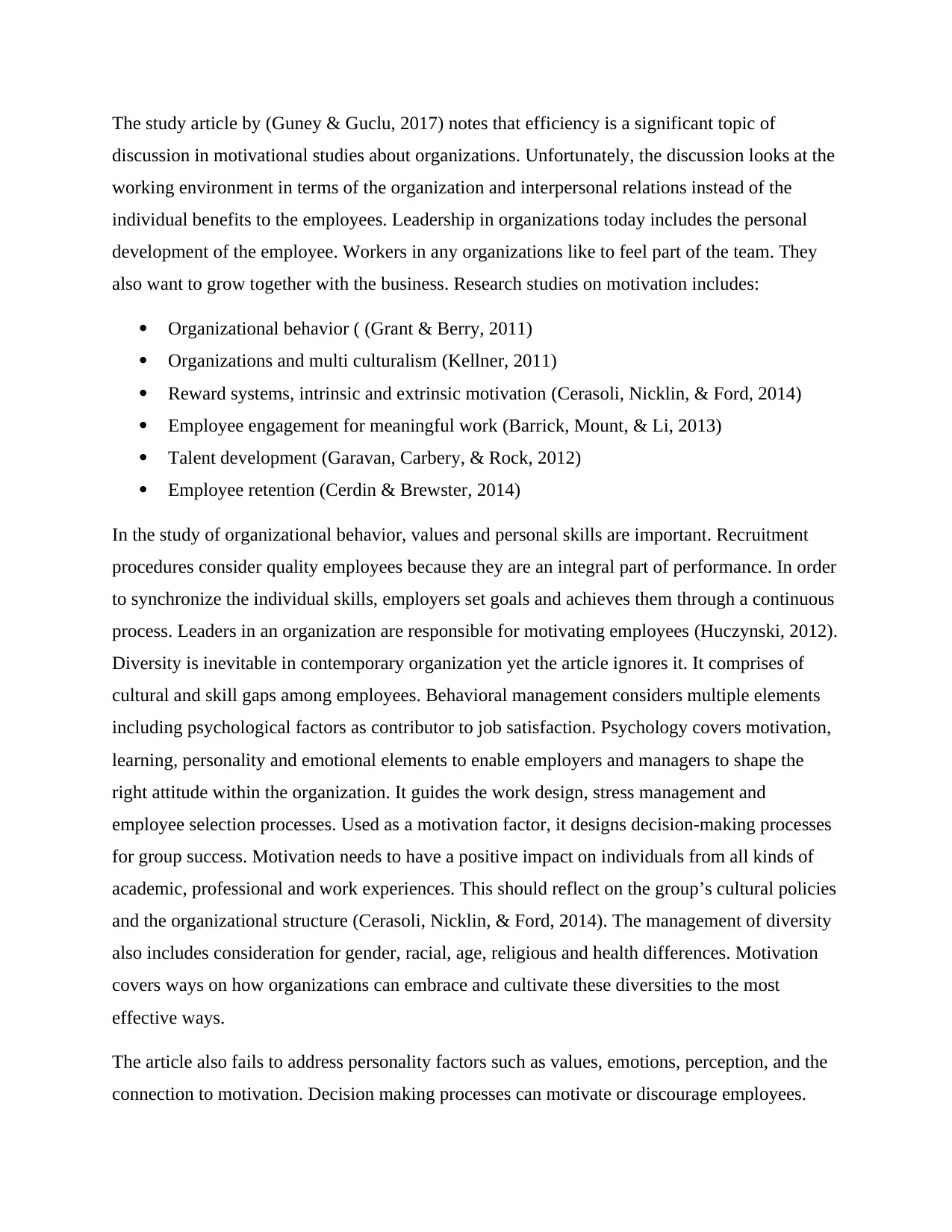
The study article by (Guney & Guclu, 2017) notes that efficiency is a significant topic of
discussion in motivational studies about organizations. Unfortunately, the discussion looks at the
working environment in terms of the organization and interpersonal relations instead of the
individual benefits to the employees. Leadership in organizations today includes the personal
development of the employee. Workers in any organizations like to feel part of the team. They
also want to grow together with the business. Research studies on motivation includes:
Organizational behavior ( (Grant & Berry, 2011)
Organizations and multi culturalism (Kellner, 2011)
Reward systems, intrinsic and extrinsic motivation (Cerasoli, Nicklin, & Ford, 2014)
Employee engagement for meaningful work (Barrick, Mount, & Li, 2013)
Talent development (Garavan, Carbery, & Rock, 2012)
Employee retention (Cerdin & Brewster, 2014)
In the study of organizational behavior, values and personal skills are important. Recruitment
procedures consider quality employees because they are an integral part of performance. In order
to synchronize the individual skills, employers set goals and achieves them through a continuous
process. Leaders in an organization are responsible for motivating employees (Huczynski, 2012).
Diversity is inevitable in contemporary organization yet the article ignores it. It comprises of
cultural and skill gaps among employees. Behavioral management considers multiple elements
including psychological factors as contributor to job satisfaction. Psychology covers motivation,
learning, personality and emotional elements to enable employers and managers to shape the
right attitude within the organization. It guides the work design, stress management and
employee selection processes. Used as a motivation factor, it designs decision-making processes
for group success. Motivation needs to have a positive impact on individuals from all kinds of
academic, professional and work experiences. This should reflect on the group’s cultural policies
and the organizational structure (Cerasoli, Nicklin, & Ford, 2014). The management of diversity
also includes consideration for gender, racial, age, religious and health differences. Motivation
covers ways on how organizations can embrace and cultivate these diversities to the most
effective ways.
The article also fails to address personality factors such as values, emotions, perception, and the
connection to motivation. Decision making processes can motivate or discourage employees.
discussion in motivational studies about organizations. Unfortunately, the discussion looks at the
working environment in terms of the organization and interpersonal relations instead of the
individual benefits to the employees. Leadership in organizations today includes the personal
development of the employee. Workers in any organizations like to feel part of the team. They
also want to grow together with the business. Research studies on motivation includes:
Organizational behavior ( (Grant & Berry, 2011)
Organizations and multi culturalism (Kellner, 2011)
Reward systems, intrinsic and extrinsic motivation (Cerasoli, Nicklin, & Ford, 2014)
Employee engagement for meaningful work (Barrick, Mount, & Li, 2013)
Talent development (Garavan, Carbery, & Rock, 2012)
Employee retention (Cerdin & Brewster, 2014)
In the study of organizational behavior, values and personal skills are important. Recruitment
procedures consider quality employees because they are an integral part of performance. In order
to synchronize the individual skills, employers set goals and achieves them through a continuous
process. Leaders in an organization are responsible for motivating employees (Huczynski, 2012).
Diversity is inevitable in contemporary organization yet the article ignores it. It comprises of
cultural and skill gaps among employees. Behavioral management considers multiple elements
including psychological factors as contributor to job satisfaction. Psychology covers motivation,
learning, personality and emotional elements to enable employers and managers to shape the
right attitude within the organization. It guides the work design, stress management and
employee selection processes. Used as a motivation factor, it designs decision-making processes
for group success. Motivation needs to have a positive impact on individuals from all kinds of
academic, professional and work experiences. This should reflect on the group’s cultural policies
and the organizational structure (Cerasoli, Nicklin, & Ford, 2014). The management of diversity
also includes consideration for gender, racial, age, religious and health differences. Motivation
covers ways on how organizations can embrace and cultivate these diversities to the most
effective ways.
The article also fails to address personality factors such as values, emotions, perception, and the
connection to motivation. Decision making processes can motivate or discourage employees.
Paraphrase This Document
Need a fresh take? Get an instant paraphrase of this document with our AI Paraphraser
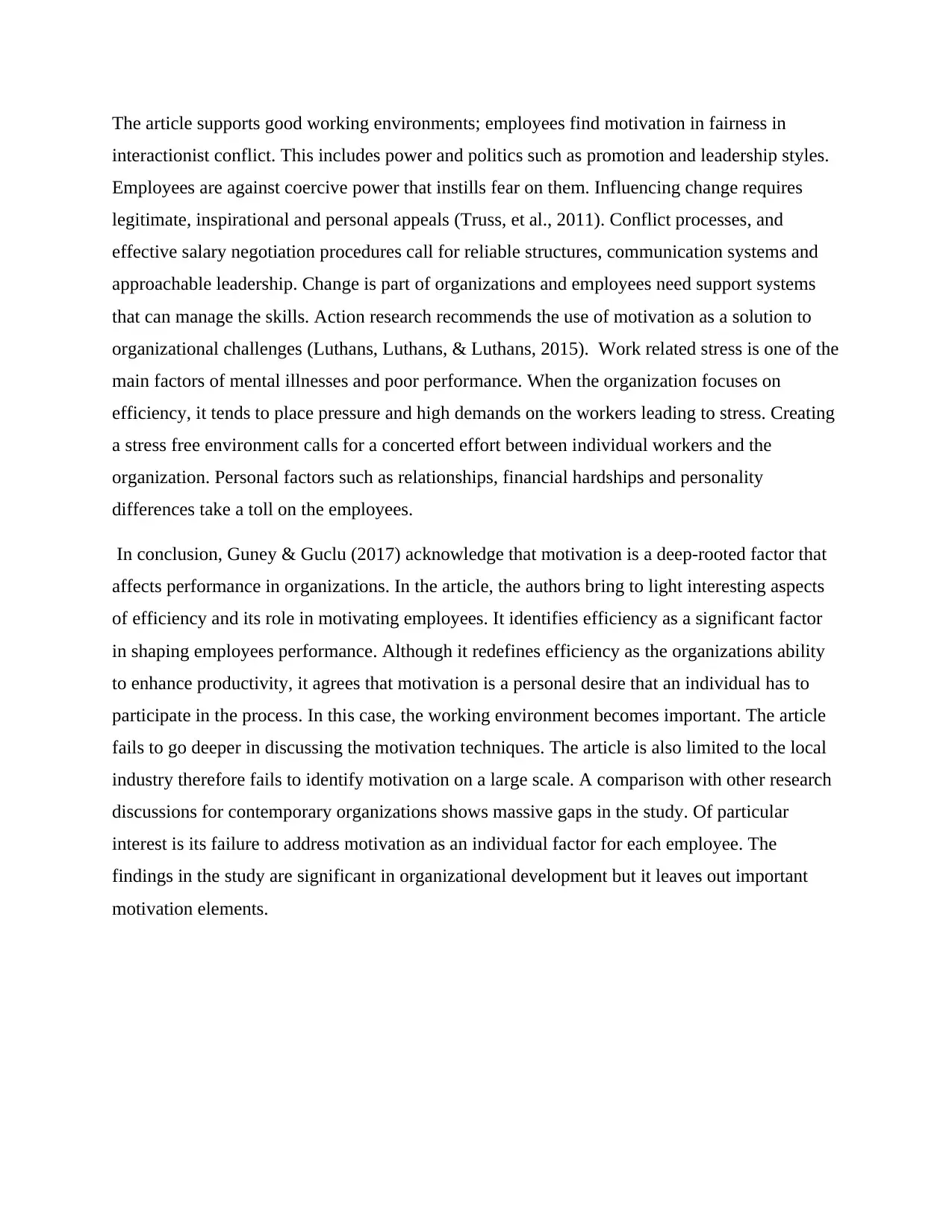
The article supports good working environments; employees find motivation in fairness in
interactionist conflict. This includes power and politics such as promotion and leadership styles.
Employees are against coercive power that instills fear on them. Influencing change requires
legitimate, inspirational and personal appeals (Truss, et al., 2011). Conflict processes, and
effective salary negotiation procedures call for reliable structures, communication systems and
approachable leadership. Change is part of organizations and employees need support systems
that can manage the skills. Action research recommends the use of motivation as a solution to
organizational challenges (Luthans, Luthans, & Luthans, 2015). Work related stress is one of the
main factors of mental illnesses and poor performance. When the organization focuses on
efficiency, it tends to place pressure and high demands on the workers leading to stress. Creating
a stress free environment calls for a concerted effort between individual workers and the
organization. Personal factors such as relationships, financial hardships and personality
differences take a toll on the employees.
In conclusion, Guney & Guclu (2017) acknowledge that motivation is a deep-rooted factor that
affects performance in organizations. In the article, the authors bring to light interesting aspects
of efficiency and its role in motivating employees. It identifies efficiency as a significant factor
in shaping employees performance. Although it redefines efficiency as the organizations ability
to enhance productivity, it agrees that motivation is a personal desire that an individual has to
participate in the process. In this case, the working environment becomes important. The article
fails to go deeper in discussing the motivation techniques. The article is also limited to the local
industry therefore fails to identify motivation on a large scale. A comparison with other research
discussions for contemporary organizations shows massive gaps in the study. Of particular
interest is its failure to address motivation as an individual factor for each employee. The
findings in the study are significant in organizational development but it leaves out important
motivation elements.
interactionist conflict. This includes power and politics such as promotion and leadership styles.
Employees are against coercive power that instills fear on them. Influencing change requires
legitimate, inspirational and personal appeals (Truss, et al., 2011). Conflict processes, and
effective salary negotiation procedures call for reliable structures, communication systems and
approachable leadership. Change is part of organizations and employees need support systems
that can manage the skills. Action research recommends the use of motivation as a solution to
organizational challenges (Luthans, Luthans, & Luthans, 2015). Work related stress is one of the
main factors of mental illnesses and poor performance. When the organization focuses on
efficiency, it tends to place pressure and high demands on the workers leading to stress. Creating
a stress free environment calls for a concerted effort between individual workers and the
organization. Personal factors such as relationships, financial hardships and personality
differences take a toll on the employees.
In conclusion, Guney & Guclu (2017) acknowledge that motivation is a deep-rooted factor that
affects performance in organizations. In the article, the authors bring to light interesting aspects
of efficiency and its role in motivating employees. It identifies efficiency as a significant factor
in shaping employees performance. Although it redefines efficiency as the organizations ability
to enhance productivity, it agrees that motivation is a personal desire that an individual has to
participate in the process. In this case, the working environment becomes important. The article
fails to go deeper in discussing the motivation techniques. The article is also limited to the local
industry therefore fails to identify motivation on a large scale. A comparison with other research
discussions for contemporary organizations shows massive gaps in the study. Of particular
interest is its failure to address motivation as an individual factor for each employee. The
findings in the study are significant in organizational development but it leaves out important
motivation elements.

References
Barrick, M. R., Mount, M. K., & Li, N. (2013). The theory of purposeful work behavior: The
role of personlaity, higher-order goals, and job characteristics. Academy of Management
Review, 38(1), 132-153.
Cerasoli, C. P., Nicklin, J., & Ford, M. T. (2014). Intrinsic motivation and extrinsic incentives
jointly predict performance: A 40-year meta-analysis. Psychological bulletin, 140(4),
980.
Cerdin, J. L., & Brewster, C. (2014). Talent development and expatriation: Bridging two streams
of research and practice. Journal of World Business, 245-252. Retrieved from
http://rcim.rmutr.ac.th/wp-content/uploads/2016/05/338-Job-Satisfaction-as-an-
Antecedent-.pdf
Cherry, K. (2017, August 4). Motivation: Psychological factors that guide behavior. Retrieved
from verywell.com: https://www.verywell.com/what-is-motivation-2795378
Garavan, T. N., Carbery, R., & Rock, A. (2012). Mapping talent development: definition, scope
and architecture. European Journal of Training and Development, 36(1), 5-24.
Grant, A. M., & Berry, J. W. (2011). The neccessity of others is the mother of invention:
Intrinsic and prosocial motivations, perspective taking, and creativity. Academy of
Management Journal, 73-96.
Guney, S., & Guclu, H. (2017, January). The Effect of the motivation techniques used by
managers to increase the productivity of their workers and application. Businness
Management Dynamics, 6(7), 1-18. Retrieved September 23, 2017, from
https://holmes.blackboard.com/bbcswebdav/pid-145052-dt-content-rid-1121585_1/
courses/HC1052B_T2_2017/The%20effect%20of%20motivation%20techniques
%202017.pdf
Hansen, D. (2011, Dec 2). 5 Keys for developing talent in your organization. Forbes. Retrieved
September 23, 2017, from F: https://www.forbes.com/sites/drewhansen/2011/12/02/5-
keys-developing-talent-in-your-organization/#741d38c229a8
Huczynski, A. (2012). Management Gurus. Routledge.
Barrick, M. R., Mount, M. K., & Li, N. (2013). The theory of purposeful work behavior: The
role of personlaity, higher-order goals, and job characteristics. Academy of Management
Review, 38(1), 132-153.
Cerasoli, C. P., Nicklin, J., & Ford, M. T. (2014). Intrinsic motivation and extrinsic incentives
jointly predict performance: A 40-year meta-analysis. Psychological bulletin, 140(4),
980.
Cerdin, J. L., & Brewster, C. (2014). Talent development and expatriation: Bridging two streams
of research and practice. Journal of World Business, 245-252. Retrieved from
http://rcim.rmutr.ac.th/wp-content/uploads/2016/05/338-Job-Satisfaction-as-an-
Antecedent-.pdf
Cherry, K. (2017, August 4). Motivation: Psychological factors that guide behavior. Retrieved
from verywell.com: https://www.verywell.com/what-is-motivation-2795378
Garavan, T. N., Carbery, R., & Rock, A. (2012). Mapping talent development: definition, scope
and architecture. European Journal of Training and Development, 36(1), 5-24.
Grant, A. M., & Berry, J. W. (2011). The neccessity of others is the mother of invention:
Intrinsic and prosocial motivations, perspective taking, and creativity. Academy of
Management Journal, 73-96.
Guney, S., & Guclu, H. (2017, January). The Effect of the motivation techniques used by
managers to increase the productivity of their workers and application. Businness
Management Dynamics, 6(7), 1-18. Retrieved September 23, 2017, from
https://holmes.blackboard.com/bbcswebdav/pid-145052-dt-content-rid-1121585_1/
courses/HC1052B_T2_2017/The%20effect%20of%20motivation%20techniques
%202017.pdf
Hansen, D. (2011, Dec 2). 5 Keys for developing talent in your organization. Forbes. Retrieved
September 23, 2017, from F: https://www.forbes.com/sites/drewhansen/2011/12/02/5-
keys-developing-talent-in-your-organization/#741d38c229a8
Huczynski, A. (2012). Management Gurus. Routledge.
⊘ This is a preview!⊘
Do you want full access?
Subscribe today to unlock all pages.

Trusted by 1+ million students worldwide
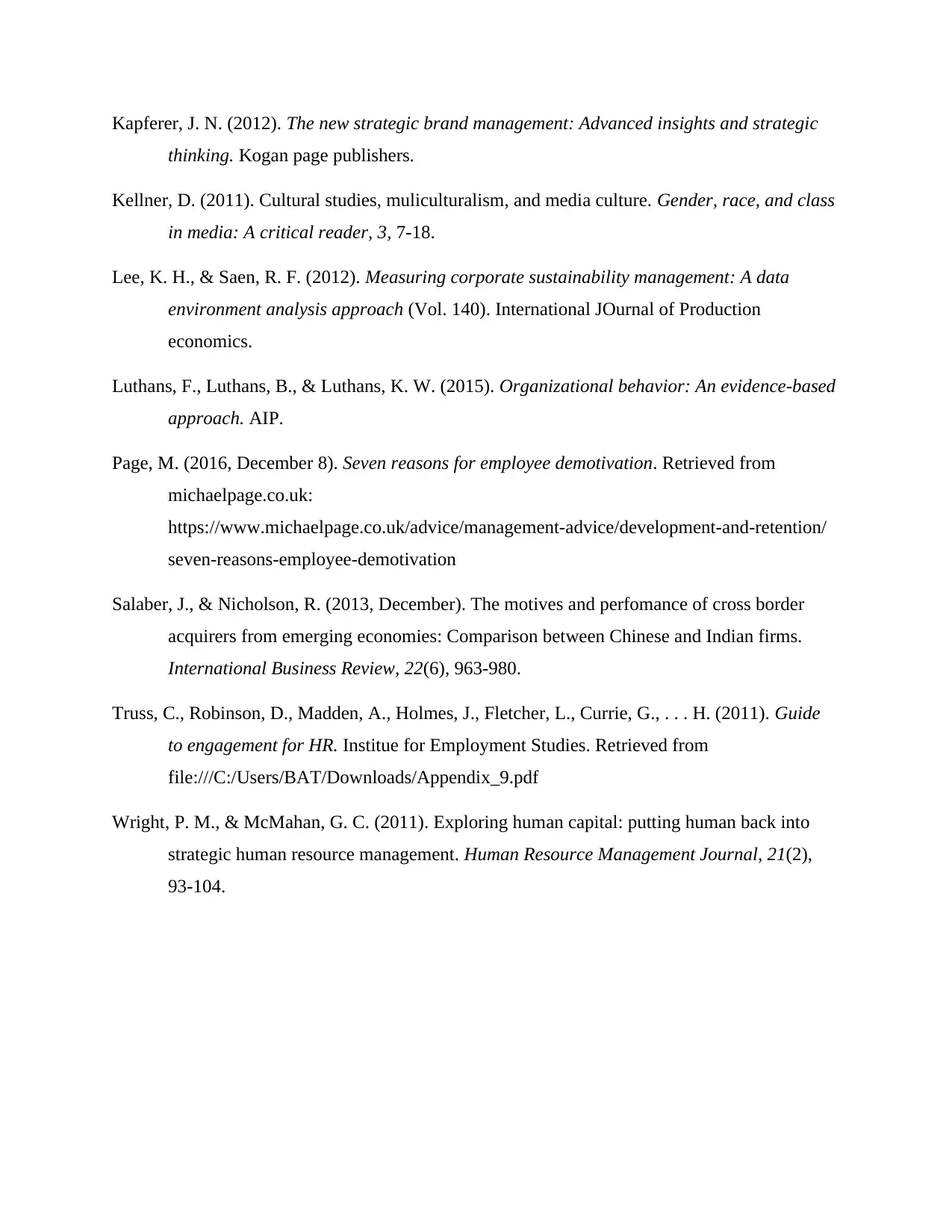
Kapferer, J. N. (2012). The new strategic brand management: Advanced insights and strategic
thinking. Kogan page publishers.
Kellner, D. (2011). Cultural studies, muliculturalism, and media culture. Gender, race, and class
in media: A critical reader, 3, 7-18.
Lee, K. H., & Saen, R. F. (2012). Measuring corporate sustainability management: A data
environment analysis approach (Vol. 140). International JOurnal of Production
economics.
Luthans, F., Luthans, B., & Luthans, K. W. (2015). Organizational behavior: An evidence-based
approach. AIP.
Page, M. (2016, December 8). Seven reasons for employee demotivation. Retrieved from
michaelpage.co.uk:
https://www.michaelpage.co.uk/advice/management-advice/development-and-retention/
seven-reasons-employee-demotivation
Salaber, J., & Nicholson, R. (2013, December). The motives and perfomance of cross border
acquirers from emerging economies: Comparison between Chinese and Indian firms.
International Business Review, 22(6), 963-980.
Truss, C., Robinson, D., Madden, A., Holmes, J., Fletcher, L., Currie, G., . . . H. (2011). Guide
to engagement for HR. Institue for Employment Studies. Retrieved from
file:///C:/Users/BAT/Downloads/Appendix_9.pdf
Wright, P. M., & McMahan, G. C. (2011). Exploring human capital: putting human back into
strategic human resource management. Human Resource Management Journal, 21(2),
93-104.
thinking. Kogan page publishers.
Kellner, D. (2011). Cultural studies, muliculturalism, and media culture. Gender, race, and class
in media: A critical reader, 3, 7-18.
Lee, K. H., & Saen, R. F. (2012). Measuring corporate sustainability management: A data
environment analysis approach (Vol. 140). International JOurnal of Production
economics.
Luthans, F., Luthans, B., & Luthans, K. W. (2015). Organizational behavior: An evidence-based
approach. AIP.
Page, M. (2016, December 8). Seven reasons for employee demotivation. Retrieved from
michaelpage.co.uk:
https://www.michaelpage.co.uk/advice/management-advice/development-and-retention/
seven-reasons-employee-demotivation
Salaber, J., & Nicholson, R. (2013, December). The motives and perfomance of cross border
acquirers from emerging economies: Comparison between Chinese and Indian firms.
International Business Review, 22(6), 963-980.
Truss, C., Robinson, D., Madden, A., Holmes, J., Fletcher, L., Currie, G., . . . H. (2011). Guide
to engagement for HR. Institue for Employment Studies. Retrieved from
file:///C:/Users/BAT/Downloads/Appendix_9.pdf
Wright, P. M., & McMahan, G. C. (2011). Exploring human capital: putting human back into
strategic human resource management. Human Resource Management Journal, 21(2),
93-104.
1 out of 7
Related Documents
Your All-in-One AI-Powered Toolkit for Academic Success.
+13062052269
info@desklib.com
Available 24*7 on WhatsApp / Email
![[object Object]](/_next/static/media/star-bottom.7253800d.svg)
Unlock your academic potential
Copyright © 2020–2025 A2Z Services. All Rights Reserved. Developed and managed by ZUCOL.





